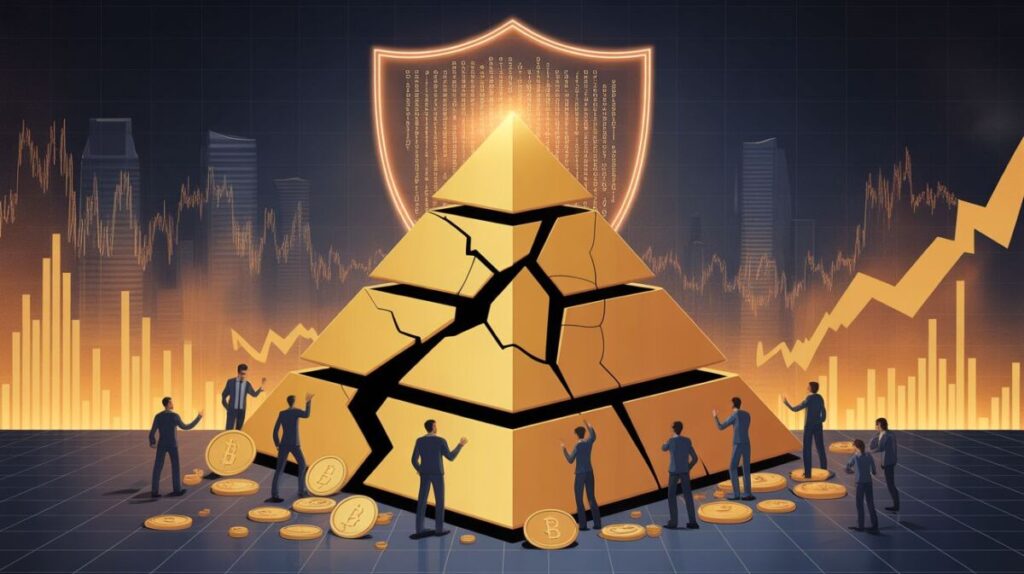
Crypto has brought financial freedom, innovation, and opportunity to millions. But where money flows quickly, scams follow even faster. The decentralized nature of crypto makes it borderless and permissionless which is exactly why scammers love it.
In 2024 alone, over $9.3 billion was stolen through crypto frauds and scams (FBI) and That’s not counting the billions lost in unreported cases, often hidden out of shame. From fake investment platforms and rug pulls to romance scams and AI-powered deepfakes, the tactics are becoming more sophisticated every year.
This article breaks down everything you need to know: how Ponzi and pyramid schemes work, the modern scam playbook, why people fall for them, real-world case studies, and most importantly how to protect yourself.
1.What Are Ponzi and Pyramid Schemes?
Before diving into crypto-specific scams, it helps to understand the foundations
1.1 Ponzi Schemes
Named after Charles Ponzi in the early 1900s, these schemes promise high, steady returns. But instead of profits coming from real investments, payouts come from new investors’ money. Eventually, when new inflows stop, the scheme collapses.
Classic Example: A promoter says, “Invest $1,000 with me, and I’ll give you 20% monthly returns.” At first, early investors are paid but the money is just recycled from new participants and When recruitment slows, the whole system crashes.
1.2 Pyramid Schemes
Pyramids differ slightly: they require participants to recruit others. You earn not from selling a product or service but from bringing in new members. Each level of the pyramid supports the one above. Eventually, there aren’t enough recruits to sustain the model, and most people lose.
Ponzi vs Pyramid – Similarities: both rely on a constant influx of new victims and collapse once growth stops.

2.Modern Crypto Scams: Beyond Ponzi
Scammers have upgraded old tricks for the digital age. Here are the most common today:
- Fake Investment Platforms: Lookalike websites mimicking real exchanges. Victims deposit funds but can never withdraw.
- Rug Pulls & Exit Scams: Developers launch a flashy token, pump it, then drain liquidity and vanish.
- Phishing & Wallet Drainers: Fake links or emails trick users into signing malicious transactions.
- Pig Butchering (Romance Scams): Long-term relationship building online, then “investment opportunities” drain victims.
- Pump-and-Dumps: Coordinated hype inflates token prices before insiders dump.
- AI Deepfakes & Fake Giveaways: Scammers impersonate influencers, CEOs, or even politicians to push fraudulent schemes.
3.Why People Fall for Crypto Scams
It’s easy to think “I’d never fall for that.” But psychology plays a huge role:
- Greed & FOMO: The promise of 10x returns overrides rational thinking.
- Urgency: “Limited-time presale” creates pressure to act without research.
- Complexity: Crypto is technically complex, making it easier to hide fraud in jargon.
- Trust Exploitation: Emotional manipulation (romance scams) and authority bias (celebrity endorsements).
Just as fishermen use bait tailored to the fish, scammers design hooks that appeal to greed, love, or fear.
4.Case Studies: Real Scams That Cost Millions
4.1 The Aqua Rug Pull (Solana, 2025)
Aqua raised $4.6M for a Telegram bot. Within hours of presale, the funds vanished. No product, no roadmap.
Lesson: Presales without audits or liquidity locks are high risk.
4.2 Aura Memecoin Pump & Dump (Solana, 2025)
Aura spiked 5,000% in a single day, then collapsed as devs went silent.
Lesson: Rapid price pumps without communication are major red flags.
4.3 Pig Butchering Scams (Asia, 2024–2025)
Victims were lured into fake relationships on WhatsApp and Instagram, then told to invest in UAI Coin. Losses reached billions globally.
Lesson: Emotional trust is often exploited. Never mix personal relationships with financial decisions.
4.4 AI Deepfake Scam Rings (2025)
87 rings uncovered in Asia used AI deepfakes to impersonate CEOs and influencers. Fake Elon Musk “giveaway” videos stole millions.
Lesson: Always cross-check announcements through official sites.
4.5 $LIBRA Token Scandal (Argentina, 2025)
Promoted by President Javier Milei, $LIBRA surged, then crashed 85%, with insiders accused of dumping.
Lesson: Political or celebrity endorsements are no guarantee of legitimacy.
5.How to Protect Yourself (Individuals)
Do Your Own Research (DYOR): Verify team, audits, tokenomics.
Check URLs: Use official links; avoid clicking random messages.
Wallet Security: Use hardware wallets, enable MFA, protect seed phrases.
Skepticism First: If returns are guaranteed, it’s a scam. Slow Down: Scammers pressure you to act quickly. Pause and verify.
6.How Businesses Can Protect Themselves
- Robust KYC/AML: Screen participants to block bad actors.
- Vendor Audits: Work only with audited projects.
- Real-Time Monitoring: Flag unusual transactions.
- Employee Training: Teach staff to recognize phishing and deepfakes.
7.How to Detect Scams: Red Flags Checklist
Spotting a scam often comes down to recognizing familiar warning signs. Be wary of any project that promises guaranteed high returns in crypto, nothing is risk-free. If the team is anonymous or impossible to verify, that’s another strong red flag. The absence of independent audits or locked liquidity should immediately raise questions about a project’s credibility. Many scams also rely on high-pressure tactics, urging you to invest quickly with lines like “limited time only.” Finally, don’t let celebrity or influencer endorsements sway you; history shows that paid promotions or fake endorsements are a common cover for fraudulent activity.
Fortunately, there are tools that can help. Rug pull scanners such as TokenSniffer or StaySafu can automatically flag risky contracts. Explorers like Etherscan or Solscan let you dig deeper into token supply and wallet activity. And if in doubt, community watchdog groups on forums and social platforms often expose suspicious projects before they gain momentum.
8.How to Report Scams
Authorities: In the U.S. → FBI, SEC, FTC.
Exchanges: Report fraudulent tokens to platforms. Community: Share warnings on Twitter/X, Reddit, Telegram.
9.Conclusion
From Charles Ponzi in 1920 to Aqua on Solana in 2025, the schemes have changed but the patterns are constant. They prey on greed, urgency, and trust.
Crypto is not inherently unsafe but it is a powerful tool. Used right, it builds wealth and opportunity. Used wrong, it becomes the perfect bait for scammers. The best defense is knowledge, skepticism, and slow, deliberate decision-making.
Disclaimer: This content is for educational and reference purposes only and does not constitute any investment advice. Digital asset investments carry high risk. Please evaluate carefully and assume full responsibility for your own decisions.
Join MEXC and Get up to $10,000 Bonus!



